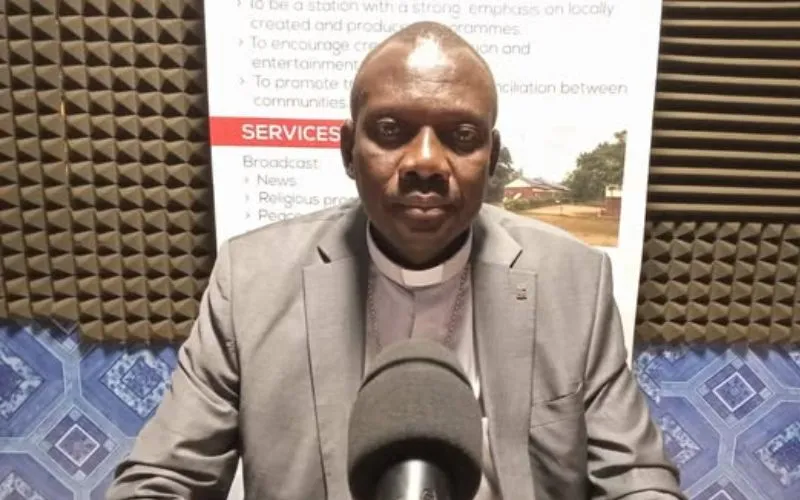The date of the discovery: the evening of Dec. 7, the vigil of the Immaculate Conception Solemnity.
The clean, spring-fed water was immediately celebrated as a gift from the Virgin Mary. And when Bishop Cornelius Kipng’eno Arap Korir, leader of the Diocese of Eldoret at the time, celebrated the inaugural Mass at the shrine on Jan. 1, 1992 — the Solemnity of Mary, Mother of God — he blessed the water.
 Franciscan Father Raymond Ogutu Owino, rector of the Subukia national Marian shrine, stands beside a pool containing what many believe is “healing water."(Photo: Jonathan Liedl)
Franciscan Father Raymond Ogutu Owino, rector of the Subukia national Marian shrine, stands beside a pool containing what many believe is “healing water."(Photo: Jonathan Liedl)
“They said, ‘It is Our Lady that has given this,’” explained Franciscan Father Raymond Ogutu Owino, a native Kenyan who serves as the shrine’s rector. “A gift from Mama.”
Stories of Healings
(Story continues below)
People soon started comparing the spring to Lourdes, France, where St. Bernadette had scraped away soil to reveal a miraculous spring after being instructed by the Blessed Mother to “drink from the fountain and bathe in it.”
And very quickly, the Kenyan spring became associated with another feature of the Marian apparition site in France: miraculous healings.
In fact, already in 1993, Nakuru Bishop R.S. Nidngi Mwanza’a Nzeki mentioned in a pamphlet on the shrine that belief in the healing properties of Subukia’s water was widespread.
Father Szulc says that the earliest known claim of healing didn’t involve a native Kenyan, but a German.
The German artist, who had helped design a cross at the shrine, had a withered hand that had withstood all modern medical efforts to revive it. But when he washed his hands in Subukia’s spring, he experienced a searing pain and went to others for help. When he uncovered the hand, he found that it was healed.
 50,000 pilgrims travel to the shrine for the national prayer day in early October.
50,000 pilgrims travel to the shrine for the national prayer day in early October.
Similar stories are numerous: A Nairobi woman who had always mocked those who believed came to the shrine when she was diagnosed with a brain tumor, washed in the waters, and the tumor disappeared; a cancer-ridden man from India came to the waters of Subukia and returned only weeks later, this time to give thanks that his body was cancer-free.
In 2013, a different kind of miracle allegedly occurred. A dispute had broken out between pilgrims squabbling over access to the water. In the midst of the fracas, something happened that had never happened before: The spring stopped.
Pilgrims came to the Franciscan friar on duty at the time in great agitation, and he instructed them to pray. The groups offered Rosaries and sang Marian hymns, and within a few hours, the water from the spring began to flow again.
Real or Not?
Local Church authorities have never launched an official investigation into the claims of miraculous healings at Subukia and have never given a positive or negative ruling on the alleged supernatural properties of its waters.
Nakuru’s current bishop, Bishop Cleophas Oseso Tuka, said he is taking a “wait-and-see” approach, but he also hasn’t seen any red flags associated with Subukia’s water, such as “staged healings” common with Pentecostal ministers in Africa.
He added that the Vatican’s recently issued guidance for judging apparitions and supernatural phenomenon could be “a guide that can help us to be able to authenticate” what — if anything — is truly miraculous at the shrine.
Bishop Oseso also said that while the local Church is certainly open to the miraculous happening at Subukia, he believes the shrine offers a broader “invitation to prayer and spiritual nourishment.”
 Ceiling inside the main church almost completed.(Photo: Jonathan Liedl)
Ceiling inside the main church almost completed.(Photo: Jonathan Liedl)
“If a miracle comes, well and good,” the Nakuru bishop told the Register. “But I think the major things people go there for is prayer. And in prayer, God has different ways of performing miracles,” such as spiritual healings or shifts in perspective.
Father Ogutu said that Subukia is a place where people can be closer to God, especially when they realize they have problems that only he can solve. Father Szulc said that when pilgrims come to Subkia, for whatever reason, it becomes a “point of contact” for a deeper relationship with the Father.
The Franciscans at Subukia aim to facilitate this relationship by making the site a place rich in intercessory prayer and the sacraments. They pray for the pilgrim’s intentions, offer confession, and celebrate the Eucharist at various parts of the shrine, including near the spring, where a wooden structure has been built to host Mass. A Rosary walk leads down from the hilltop, and the shrine’s large main church — adorned with Marian mosaics and a ceiling designed to appear like a blossoming flower — is nearing completion.
 Sign says 'Way of the Cross in Swahili.'(Photo: Jonathan Liedl)
Sign says 'Way of the Cross in Swahili.'(Photo: Jonathan Liedl)
The Polish friar said that the while the waters of Subukia may draw people to the shrine, it is their faith in Jesus Christ and their dependence upon God that ultimately provides healing.
“When they come here, they are different people. They find peace; they find joy; they find strength. Their faith is increasing so much. You see that this place is really helping.”
 The original spring is enclosed in a small chapel, while its waters flow to three lower pools. one for drinking, the next for hand washing, and the lowest one for full immersion.
The original spring is enclosed in a small chapel, while its waters flow to three lower pools. one for drinking, the next for hand washing, and the lowest one for full immersion.



 Pilgrims filling their jerrycans at the pool.
Pilgrims filling their jerrycans at the pool.
 Mosaic assembled in Poland with glass from Italy graces the inside of the main church, nearly completed.(Photo: Jonathan Liedl)
Mosaic assembled in Poland with glass from Italy graces the inside of the main church, nearly completed.(Photo: Jonathan Liedl) Franciscan Father Raymond Ogutu Owino, rector of the Subukia national Marian shrine, stands beside a pool containing what many believe is “healing water."(Photo: Jonathan Liedl)
Franciscan Father Raymond Ogutu Owino, rector of the Subukia national Marian shrine, stands beside a pool containing what many believe is “healing water."(Photo: Jonathan Liedl) 50,000 pilgrims travel to the shrine for the national prayer day in early October.
50,000 pilgrims travel to the shrine for the national prayer day in early October. Ceiling inside the main church almost completed.(Photo: Jonathan Liedl)
Ceiling inside the main church almost completed.(Photo: Jonathan Liedl) Sign says 'Way of the Cross in Swahili.'(Photo: Jonathan Liedl)
Sign says 'Way of the Cross in Swahili.'(Photo: Jonathan Liedl)


